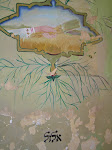We had an interesting and illuminating visit from Jonathan Shore today, a previous Vice President of the Shul who spearheaded the fundraising and renovation project that was completed in November of 2007. Though Jonathan voiced deep concerns about going down the conservation/preservation road, he also expressed his support for the project and his hopes that the shul will continue to improve the building and the interior. One comment, though, stuck in my head as it is something I have heard before from people I've met in the shul - that "this isn't Eldridge Street." By this, people mean both that it isn't possible for Stanton to raise the kinds of funds that the Eldridge Street Shul raised for their renovation, and that this shul strongly feels that it does not want to become a "museum" to Jewish history, but wants to remain an active and alive Jewish community.
I want to address the fear here that "preservation" is synonymous with a museum - or, for that matter, that "museum" is synonymous with "dead"! From my point of view as a conservator, "preserving" this historic interior does not mean leaving it as an untouched time capsule, decaying before our very eyes. It means respecting the efforts, ideas and lives of those who created this space, and doing as much as we can to reveal their original handiwork, to reveal the space that they created in which to gather and pray, and to live in that space as they lived in it.
The notion of place is very strong in Judaism, isn't it? The physical place, the enclosure in which the divine dwells, the centerpiece of the community. Being at the shul always makes me think of how it must have felt being a newcomer to this country, finding your way, and how important it was to recreate the familiar structures and relationships, to produce the visual reminders of home. I was thrilled when Elissa showed me a painting from Mayer Kirshenblatt's book, on view now at the Jewish Museum, of his childhood shul in Apt, Poland - there they were, the mazelos (also see the lovely multimedia page at the Jewish Museum website). It must have been heartwarming for the shul's congregants to see them again in New York. When I spend a day or, more recently, a week straight looking closely at the painting of the B'sullah, I never fail to see the hand that gently drew in the strands of wheat, that painted in the soft focus of the trees on the horizon and the blue and white of the clouds in the sky. The delicacy of the painting and the subtlety of the transitions between colors is largely obscured now, but the skill and care with which these were painted is clearly evident with a closer look. I feel strongly that this care and this effort must be honored, and must not be thrown away simply because it has been damaged.
I grew up with the notion that Jews valued history, lived and breathed the past, not in a regressive or stagnant way but in a way that celebrated the beauty and the strength of those who came before us. We study what they wrote, what they did, discuss how it relates to our current lives, use it, learn from it. This has a lot to do with why I chose the conservation profession, but that's a different topic. Jonathan had a lovely idea of working with local schools to create interpretations of the mazelos and display these in the shul. It's a beautiful idea. I feel, though, that in order to learn from the experience, the students must also know the original mazelos and experience the original space, to know that someone before them took the care and time to create this beautiful cycle. The mazelos have meaning on so many levels, Jewish and non, and their importance to the original Stanton community cannot be understated; but it isn't only the subject matter that matters here. Why do people travel to Jerusalem when they could very well look at a photo of the Wall online - or go to see Michelangelo's David in Florence when there are dozens of copies, even ones you can put on your coffee table? There is clearly something about the physical place and physical presence of Art - whether it's considered "high" or "low", whatever you think about its aesthetics - that holds power and energy for people. The paintings at the Stanton Street Shul have that energy, and though it may be obscured under the layers of the years, it is important that it now be brought to light.
Subscribe to:
Post Comments (Atom)
01.jpg)
I think this is a really interesting and thoughful post! I also am thrilled to see how the earlier paintwork emerges from below the later overpaint as we (mostly Roos, Beth, Melanie and Harriet)-- and am lucky to enough to work on the project, such that I get to witness from close up how delicate and lovely those painterly strokes are.
ReplyDelete